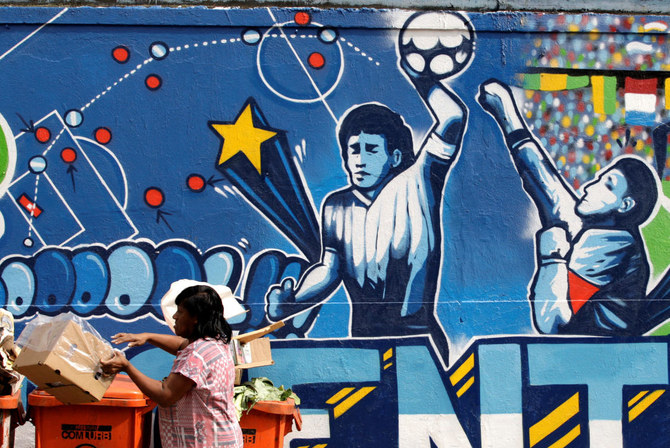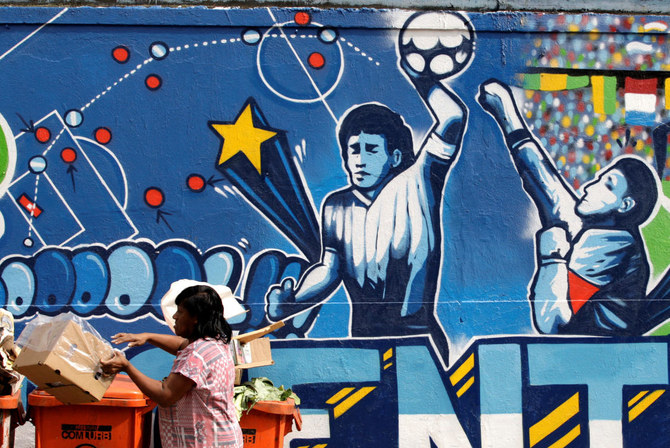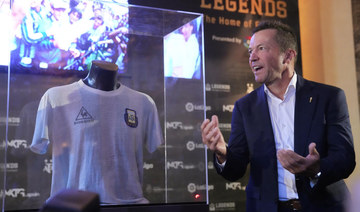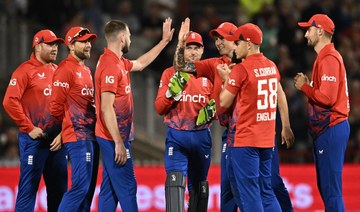The ball used when Diego Maradona scored his “Hand of God” goal against England at the 1986 World Cup has been put up for auction by the Tunisian referee who was in charge of the game and missed soccer’s most famous handball.
Graham Budd Auctions said Thursday that they expect the 36-year-old Adidas ball, which referee Ali Bin Nasser owns, to fetch between $2.7 million and $3.3 million when it goes up for sale in Britain on Nov. 16, four days before the World Cup in Qatar kicks off.
The goal that gave Argentina a 1-0 lead in the quarterfinal against England in Mexico City has become part of World Cup legend. Maradona jumped as if to head the ball but instead punched it past goalkeeper Peter Shilton. England players protested to Nasser but the goal stood. Maradona quipped afterward that it was scored “a little with the head of Maradona and a little with the hand of God,” leading to its iconic name.
Maradona used the same ball, the only one used in the quarterfinal, for his brilliant second goal four minutes later. The Argentina great ran 68 meters from his own half and weaved his way past half the England team before slipping the ball past Shilton. That goal was voted the World Cup Goal of the Century in 2002.
Argentina won the game 2-1 and went on to lift the World Cup, and the tournament launched Maradona as one of the game’s greatest players. Maradona died in 2020 at the age of 60.
“This ball is part of international football history,” Nasser said in a statement from Graham Budd Auctions. “It feels like the right time to be sharing it with the world.”
The shirt worn by Maradona in that game against England was sold for $9.3 million at an auction in May, which was at the time the highest price ever paid at auction for a piece of sports memorabilia. The record was beaten by a 1952 Topps Mickey Mantle baseball card, which sold for $12.6 million in August.
Nasser will also auction the referee shirt he wore for the quarterfinal, Graham Budd Auctions said, and another shirt that Maradona signed for his “eternal friend” at a reunion years after the game.
Maradona ‘Hand of God’ World Cup ball to be auctioned
https://arab.news/5hssj
Maradona ‘Hand of God’ World Cup ball to be auctioned

- Graham Budd Auctions said that they expect the 36-year-old Adidas ball, which Tunisian referee Ali Bin Nasser owns, to fetch between $2.7 million and $3.3 million
- The shirt worn by Maradona in that game against England was sold for $9.3 million at an auction in May
Taif to host first group race as King Faisal Cup is upgraded

- Competition becomes only G3 for 3-year-old purebred Arabians on dirt in the GCC region
RIYADH: Taif’s King Khalid Racecourse is to stage a group race for the first time this season after it was announced that September’s King Faisal Cup has been upgraded to Group 3 level by the International Federation of Arabian Horse Racing Authorities.
The $267,000 (SR1 million) contest, which was run as an international Listed race last season, will become the only Group 3 race on dirt for 3-year-old purebred Arabians in the GCC (Gulf Cooperation Council) region.
It is a landmark for Saudi Arabia’s summer racecourse and demonstrates the continued growth and improvement of the purebred Arabian program, underlining the importance of racing in Saudi Arabian culture.
The Group 3 King Faisal Cup will be run on Friday, Sept. 20, at the racecourse in Taif, where it will be supported on the card by the Listed Abdullah Al-Faisal Cup, also for purebred Arabians.
The King Faisal Cup was won last year by the Saad Mutlaq-trained Nadem Al-Molwk Al-Khalediah, who was ridden to success by leading local jockey Adel Al-Faridi.
The racing season at King Khalid Racecourse begins on Thursday, July 4, with the campaign featuring 39 fixtures and culminating on Saturday, Sept. 28.
Ziad Al-Mogren, the CEO of the Jockey Club of Saudi Arabia, said: “The upgrading of the King Faisal Cup marks an important milestone for racing in Taif, with it being the first-ever group race that will be contested at King Khalid Racecourse.
“We are proud to be raising the level of racing, both purebred Arabian and thoroughbred, throughout our Taif and Riyadh seasons, and this remains a key part of the Jockey Club of Saudi Arabia’s strategy.
“With the King Faisal Cup becoming the only Group 3 contest on dirt for 3-year-old Arabians in the region, it displays our ongoing commitment to develop and showcase world-class purebred Arabian racing, a tradition that is of huge significance to local Saudi Arabian culture.”
UFC’s Dana White announces main card for Abu Dhabi fight night

- White reveals bouts featuring some of the sport’s biggest names, contenders competing in MMA
- Sandhagen-Nurmagomedov showdown dubbed ‘No.1 contender fight’
ABU DHABI: The Ultimate Fighting Championship’s CEO Dana White confirmed on his social media platforms on Thursday the main card for the fight night on Aug. 3 which features Cory Sandhagen and Umar Nurmagomedov facing off in Abu Dhabi.
White also revealed a five-pack of intriguing bouts featuring some of the sport’s biggest names and contenders competing in mixed martial arts.
White dubbed the Sandhagen-Nurmagomedov battle a “No.1 contender fight.”
Sandhagen, 32, has been away from fighting since August 2023 after having sustained a tricep injury during his fight against Rob Font. The American MMA fighter won the bout against Font during five rounds in Tennessee.
Returning to the ring for the first time since his injury, Sandhagen is back in Abu Dhabi to cement his status as top contender in the bantamweight division.
The matchup is a rebooking of what was to be the main event in Nashville in August 2023 before a shoulder injury forced Nurmagomedov out of the original bout.
Russian Nurmagomedov, 35, has been called “the best prospect” by White and enters the challenge undefeated.
He has a great chance to catapult himself into the shark pit that is the elite at bantamweight with a win over Sandhagen.
MMA legend Nick Diaz returns to the welterweight division to face all-action fan favorite Vicente Luque. Diaz, a 40-year-old American, was last seen at UFC 266 when he faced Robbie Lawler, but the trip back down to 170 pounds is his first since he fought Georges St-Pierre for the welterweight title in March 2013.
Luque, a 32-year-old Brazilian-American, hopes to bounce back with a big win over a big name after he fell to Joaquin Buckley in Atlantic City in March.
Elsewhere on the main card, the bantamweight spotlight shines on “Chito” Vera as he takes on former flyweight champion Deiveson Figueiredo.
Vera, a 31-year-old Ecuadorian, is keen to bounce back after a disappointing result in his rematch with champ “Suga” Sean O’Malley at UFC 299.
Meanwhile, in the UFC’s women’s strawweight division, Mackenzie Dern and Loopy Godinez lock horns, with both fighters hoping to restart a run toward the top of the division.
In the main card opener, Tony Ferguson faces Michael Chiesa. Ferguson, a real legend of the sport, is hoping to finally see his hand raised for the first time since June 2019 at the conclusion of the welterweight contest.
Saudi national football team prepares for Asian qualifiers

- Players participating in the King’s Cup final between Al-Nasser and Al-Hilal on Friday will join the national squad on Sunday
- Green Falcons fly to Islamabad on Wednesday for their game against Pakistan on Thursday, and then host Jordan in Riyadh on June 11
RIYADH: The Saudi national football team gathered at their training camp in Riyadh on Thursday to begin preparations for the upcoming Asian qualifiers for the 2026 World Cup and the 2027 Asian Cup.
As the Green Falcons held their first training session on Thursday evening behind closed doors at Mahd Academy, members of the squad from Al-Nasser and Al-Hilal, who will meet in the final of the King’s Cup on Friday, were absent. They will join the national team’s preparations on Sunday after head coach Roberto Mancini gave them a day off on Saturday to recover.
The 31-player squad, announced by Mancini last week, will fly out on Wednesday for their game against Pakistan in Islamabad on June 6, and then host Jordan at Alwal park in Riyadh on June 11.
Saudi Arabia currently tops Group G of the Asian qualifiers, with 10 points from four games, ahead of Jordan (7 points) and Tajikistan (5). Pakistan are bottom of the group having lost all four games so far.
Cricket’s ability to mock itself

- Shorter forms of cricket started as “a bit of a joke” but are now behemoths threatening longer-established formats
LONDON: In cricket, what started out as a “bit of a laugh” but turned out to be much more serious? This is not a trick question. It could refer to Test cricket’s origins. England v Australia, five-day matches, players switching allegiance between countries, a jibe by Australians to create the “ashes” of English cricket in an urn. Although this turned a bit of fun into a deadly serious contest over almost 150 years, it is not the answer.
Another possibility is the start of limited-overs cricket. The first so-called international limited-overs match was played between Australia and England on Jan. 5, 1971 in Melbourne. The first three days of a Test match had been rained off and the authorities faced a significant loss of income. They decided to abandon the match, replace it with a one-off, one-day match and add a seventh Test at the end of the series. This was much to the surprise and reluctance of the players, who were not consulted.
The English players seemed more concerned about receiving money for being asked to play extra matches. They were used to the benefits of limited-over cricket, which had started in the English and Welsh professional game in 1963 as a response to falling attendances and defensive play. Although commercially successful, with a sponsor in Gillette, no other Test-playing nation displayed any enthusiasm for the format. The decision by the Australian authorities to stage the match did not raise a laugh among the players, while the Australian Cricket Board was not laughing in the face of a serious need to generate income.
On what would have been day five of the Test match, the one-day game went ahead in a format of 40 overs, each of eight deliveries, the standard in Australia at the time. The teams were billed as an “England XI” and an “Australia XI.” Press reports referred to it as a “one-day Test match.” Any skepticism about the match by players and authorities was not shared by spectators, 46,000 of them turning up to watch.
This was a light-bulb moment for the Australian Cricket Board, whose head, Sir Donald Bradman, proclaimed: “You have seen history made.” Australia won the match, the England captain admitting that his players did not take the game seriously, although they were relieved to play some cricket after having spent so much time in the dressing room, as well as receiving an extra £50 for participating.
In this rather grumpy and fragile set of circumstances history was, indeed, created without many of the participants recognizing the significance of the event. Some years later, one Australian player recalled his surprise that a game they thought a “bit of a joke” became part of cricket’s history.
A revolution had been set in train. In 1973, the first women’s one-day world cup was staged, followed by the men’s in 1975. Kerry Packer’s breakaway World Series Cricket in 1977 in Australia shook cricket’s authorities into realizing the commercial opportunities offered by the format. At that time, Australia, England and the West Indies were dominant. India did not take the format, often referred to as “pyjama cricket” because of the use of colored kit, at all seriously.
This all changed in 1983 when not only did India take the format seriously but its team also won the one-day world cup, defeating England, Australia and the West Indies along the way, inspired by the captain, Kapil Dev. In two months, the appeal of limited-overs cricket was transformed, as the Indian public fell head-over-heels in love with it and its heroes. Triangular and quadrangular tournaments were spawned on the Indian subcontinent and Sharjah. A joke became a joyful and serious commercial activity.
Yet, this is still not the answer to the original question. At the turn of the 20th century, falling attendances in England and Wales, poor performances by the national team and the imminent banning of tobacco advertising in sport combined to create a new crisis. Based on focus groups and surveys, the England and Wales Cricket Board concluded that the population wanted a form of cricket with wider appeal in terms of both duration and form of delivery. Reduced-over formats, such as 15 eight-ball or 20 overs of six balls, had been used for decades in club cricket in mid-week evening cups. In 2002, the board proposed a new Twenty20 Cup competition for the professional game.
This was narrowly approved by the county cricket clubs and launched in May 2003 on a roof garden in central London with members of a quickly forgotten pop group appearing in a tacky photoshoot. They were accompanied by the captains of the two county teams that were to contest the first match. One of them admitted to cringing when he saw the result of the photoshoot. He also said that he found the first match, on June 13, 2003, a “bit of fun.” It was not taken too seriously, as the general view was that it would not last.
How wrong could they have been? Another piece of cricketing history had been made, without anyone understanding the significance of the event. Counties used increasingly garish methods to entertain their new breed of spectators, who responded positively, thus ensuring that the format lasted longer than many thought would be the case. Once again, India was slow to adopt the format, but when it did cricket was transformed, the subcontinent effectively hijacking the new format.
The impacts of this continue to reverberate and encroach on other formats, as well as driving the game’s global expansion. Matches in the imminent twenty-team T20 World Cup will take place in the US, and T20 cricket will be an Olympic sport in 2028. So, from being a “a bit of a laugh,” it has become the dominant format and a commercial behemoth of existential threat to longer-established formats, both of which started as a “bit of a joke.” Cricket has a way of making fools of those who joke.
Saudi boxer Ziyad Al-Maayouf: Pioneering a new era in the sport

- In Ziyad Al-Maayouf, boxing has found not just a competitor, but a pioneer
- “Hopefully very soon we’ll be bringing a belt back to Saudi.”
Riyadh: In the heart of the boxing world, where legends are made and dreams are realized, a new figure is emerging, one that embodies the fusion of tradition and innovation, heritage and progress. Ziyad Al-Maayouf, a Saudi boxer with a vision as expansive as the desert horizon, is not just stepping into the ring; he is stepping into history.
“I’m honestly just looking at it right now. And I’m looking forward to being ringside and just, you know, living the dreams of a Saudi boxer, first. But, you know, just someone who loves the sport, second,” Al-Maayouf said.
His ascent is not merely about personal glory; it is also about rewriting the narrative of boxing itself. “Hopefully very soon we’ll be bringing a belt back to Saudi,” he added, his determination palpable. “I’m not going to stop until I do that.”
For Al-Maayouf, every fight is a testament to the golden era of boxing he finds himself in. “Like I always say, this is what I would like to call the golden era of boxing,” he said, adding that the spirit of the age continues to “inspire young fighters like me to take risks, fight the best.
“The records don’t matter. You know, bring out the real fighter in you and bring out the good fights.”
As Al-Maayouf prepares for his next bout, he carries with him the hopes and dreams of a nation, the aspirations of a global audience, and the unwavering belief that in the squared circle, anything is possible. “We want to see the sport of boxing go back to the top five and maybe even the top one sport of the world.”
In Ziyad Al-Maayouf, boxing has found not just a competitor, but a pioneer — a man whose journey transcends borders, whose dreams inspire generations and whose fists carry the weight of history. As he steps into the ring, he does so not just as a fighter, but as a symbol of what boxing was, what it is, and what it can become.





















